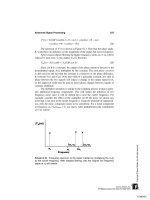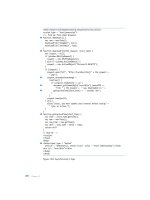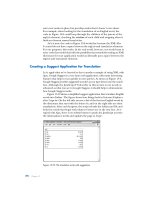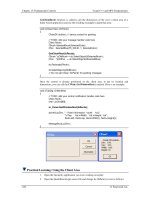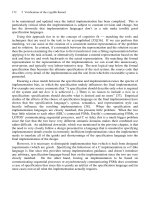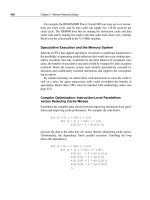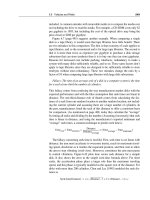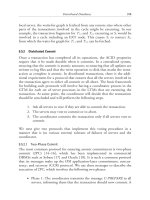OBJECT-ORIENTED ANALYSIS AND DESIGNWith application 2nd phần 7 pps
Bạn đang xem bản rút gọn của tài liệu. Xem và tải ngay bản đầy đủ của tài liệu tại đây (326.93 KB, 54 trang )
Chapter 8: Data Acquisition 317
Figure 8-14
Frame Mechanism
Now that we have refined this element of our architecture, we present a new class diagram in
Figure 8-14 that highlights this frame mechanism.
8.3 Evolution
Release Planning
Now that we have validated our architecture by walking through several scenarios, we can
proceed with the incremental development of the system's function points. We start this
process by proposing a sequence of releases, each of which builds upon the previous release:
• Develop a minimal functionality release, which monitors just one sensor.
• Complete the sensor hierarchy.
• Complete the classes responsible for managing the display.
• Complete the classes responsible for managing the user interface.
We could have ordered these releases in just about any manner, but we choose this one in
order of highest to lowest risk, thereby forcing our development process to directly attack the
hard problems first.
Developing the minimal functionality release forces us to take a vertical slice through our
architecture, and implement small parts of just about every key abstraction. This activity
addresses the highest risk in the project, namely, whether we have the right abstractions with
the right roles and responsibilities. This activity also gives us early feedback, because we can
Chapter 8: Data Acquisition 318
now play with an executable system. Indeed, as we discussed in Chapter 7, forcing early
closure like this has a number of technical and social benefits. On the technical side, it forces
us to begin to bolt the hardware and software parts of our system together, thereby
identifying any impedance mismatches early. On the social side, it allows us to get early
feedback about the look and feel of the system, from the perspective of real users.
Because completing this release is largely a manner of tactical implementation (the so-called
daily blocking and tackling that every development team must do), we will not bother with
exposing any more of its structure. However, we will now turn to elements of later releases,
because they reveal some interesting insights about the development process.
Sensor Mechanism
In inventing the architecture for this system, we have already seen how we had to iteratively
and incrementally evolve our abstraction of the sensor classes, which we began during
analysis. In this evolutionary release, we expect to build upon the earlier completion of a
minimal functional system, and finish the details of this class hierarchy.
At this point in our development cycle, the class hierarchy we first presented in Figure 8-4
remains stable, although, not surprisingly, we had to adjust the location of certain
polymorphic operations, in order to extract greater commonality. Specifically, in an earlier
section we noted the requirement for the currentValue operation, declared in the abstract base
class Sensor. We may complete our design of this class by writing the following C++
declaration:
class Sensor {
public:
Sensor(SensorName, unsigned int id = 0);
virtual ~Sensor();
virtual float currentValue() = 0;
virtual float rawValue() = 0;
SensorName name() const;
unsigned int id() const;
protected:
};
This is an abstract class because it includes pure virtual member functions.
Notice that through the class constructor, we gave the instances of this class knowledge of
their name and id. This is essentially a kind of runtime type identification, but providing this
information in unavoidable here, because per the requirements, each sensor instance must
Chapter 8: Data Acquisition 319
have a mapping to a particular memory-mapped I/O address. We can hide the secrets of this
mapping by making this address a function of a sensor name and id.
Now that we have added this new responsibility, we can now go back and simplify the
signature of DisplayManager::display to take only a single argument, namely, a reference to a
Sensor object. We can eliminate the other arguments to this member function, because the
display manager can now ask the sensor object its name and id.
Making this change is advisable, because it simplifies certain cross-class interfaces. Indeed, if
we fail to keep up with small, rippling changes such as this one, then our architecture will
eventually suffer software rot, wherein the protocols among collaborating classes becomes
inconsistently applied.
The declaration of the immediate subclass
CalibratingSensor builds upon this base class:
class CalibratingSensor : public Sensor {
public:
CalibratingSensor(SensorName, unsigned int id = 0);
virtual ~CalibratingSensor();
void setHighValue(float, float);
void setLowValue(float, float);
virtual float currentValue();
virtual float rawValue() = 0;
protected:
};
This class introduces two new operations (
setHighValue and setLowValue), and implements the
previously declared pure function currentValue.
Next, consider the declaration of the subclass HistoricalSensor, which builds upon the class
CalibratingSensor:
class HistoricalSensor : public CalibratingSensor {
public:
HistoricalSensor(SensorName, unsigned int id = 0);
virtual ~HistoricalSensor();
float highValue() const;
float lowValue() const;
const char* timeOfHighValue() const;
const char* timeOfLowValue() const;
protected:
Chapter 8: Data Acquisition 320
};
This class introduces four new operations, whose implementation requires collaboration with
the
TimeDate class. Note that HistoricalSensor is still an abstract class, because we have not yet
completed the definition of the pure virtual function
rawValue, which we defer to be a concrete
subclass responsibility.
The class TrendSensor inherits from HistoricalSensor, and adds one new responsibility:
class TrendSensor : public HistoricalSensor {
public:
TrendSensor(SensorName, unsigned int id = 0);
virtual ~TrendSensor();
float trend() const;
protected:
};
This class introduces one new member function. As with some of the other new operations
that certain intermediate classes have added, we declare trend as non-virtual, because we do
not desire that subclasses change their behavior.
Ultimately, we reach concrete subclasses such as TemperatureSensor:
class TemperatureSensor : public TrendSensor {
public:
TemperatureSensor(unsigned int id = 0);
virtual ~TemperatureSensor();
virtual float rawValue();
float currentTemperature();
protected:
};
Notice that the signature of this class's constructor is slightly different than its superclasses,
simply because at this level of abstraction, we know the specific name of the class. Also,
notice that we have introduced the operation currentTemperature, which follows from our earlier
analysis. This operation is semantically the same as the polymorphic function currentValue, but
we choose to include both of them, because the operation currentTemperature is slightly more
type-safe.
Chapter 8: Data Acquisition 321
Once we have successfully completed the implementation of all classes in this hierarchy and
integrated them with the previous release, we may proceed to the next level of the system's
functionality.
Display Mechanism
Implementing the next release, which completes the functionality of the classes
DisplayManager
and
LCDDevice, requires virtually no new design work, just some tactical decisions about the
signature and semantics of certain member functions. Combining the decisions we made
during analysis with our first architectural prototype, wherein we made some important
decisions about the protocol for displaying sensor values, we derive the following concrete
interface in C++:
class DisplayManager {
public:
DisplayManager();
~DisplayManager();
void clear();
void refresh();
void display(Sensor&);
void drawStaticItems(TemperatureScale, SpeedScale);
void displayTime(const char*);
void displayDate(const char*);
void displayTemperature(float, unsigned int id = 0);
void displayHumidity(float, unsigned int id = 0);
void displayPressure(float, unsigned int id = 0);
void displayWindChill(float, unsigned int id = 0);
void displayDewPoint(float, unsigned int id = 0);
void displayWindSpeed(float, unsigned int id = 0);
void displayWindDirection(unsigned int, unsigned int id = 0);
void displayHighLow(float, const char*, SensorName, unsigned int id =
0);
void setTemperatureScale(TemperatureScale);
void setSpeedScale(SpeedScale);
protected:
//
};
None of these operations are virtual, because we neither expect nor desire any subclasses.
Notice that this class exports several primitive operations (such as
displayTime and refresh), but
also exposes the composite operation display, whose presence greatly simplifies the action of
clients who must interact with instances of the DisplayManager.
The DisplayManager ultimately uses the resources of the class LCDDevice, which as we described
earlier, serves as a skin over the underlying hardware. In this manner, the DisplayManager
Chapter 8: Data Acquisition 322
raises our level of abstraction by providing a protocol that speaks more directly to the nature
of the problem space.
User-Interface Mechanism
The focus of our last major release is the tactical design and implementation of the classes
Keypad and InputManager. Similar to the LCDDevice class, the class KeyPad serves as a skin over the
underlying hardware, which thereby relieves the
InputManager of the nasty details of talking
directly to the hardware. Decoupling these two abstractions also makes it far easier to replace
the physical input device without destabilizing our architecture.
We start with a declaration that names the physical keys in the vocabulary of our problem
space:
enum Key {kRun, kSelect, kCalibrate, kMode,
kUp, kDown, kLeft, kRight,
kTemperature, kPressure, kHumidity, kWind, kTime,
kDate, kUnassigned};
We use the k prefix to avoid name clashes with literals defined in SensorName.
Continuing, we may capture our abstraction of the Keypad class as follows:
class Keypad {
public:
Keypad();
~Keypad();
int inputPending() const;
Key lastKeyPress() const;
protected:
};
The protocol of this class derives from our earlier analysis. We have added the operation
inputPending so that clients can query if user input exists that has not yet been processed.
The class
InputManager has a similarly sparse interface:
class InputManager {
public:
InputManager(Keypad&);
~InputManager();
void processKeyPress();
Chapter 8: Data Acquisition 323
protected:
Keypad& repKeypad;
};
As we will see, most of the interesting work of this class is carried out in the implementation
of its finite state machine.
As we illustrated in Figure 8-13, instances of the class Sampler, InputManager, and Keypad
collaborate to respond to user input. To integrate these three abstractions, we must subtly
modify the interface of the class Sampler to include a new member object, repInputManager:
class Sampler {
public:
Sampler(Sensors&, DisplayManager&, InputManager&);
protected:
Sensors& repSensors;
DisplayManager& repDisplayManager;
InputManager& repInputManager;
};
Through this design decision, we establish an association among instances of the classes
Sensors, DisplayManager, and InputManager at the time we construct an instance of Sampler. By using
references, we assert that instances of Sampler must always have a collection of sensors, a
display manager, and an input manager.
An alternate representation that used pointers would provide a looser association by
allowing a Sampler to omit one or more of its components.
We must also incrementally modify the implementation of the key member function
Sampler::sample
void Sampler::sample(Tick t)
{
repInputManager.processKeyPress();
for (SensorName name = Direction; name <= Pressure; name++)
for (unsigned int id = 0; id < repSensors.numberOfSensors(name);
id++)
if (!(t % samplingRate(name)))
repDisplayManager.display(repSensors.sensor(name,
id));
}
Here we have added an invocation to processKeyPress at the beginning of every time frame.
Chapter 8: Data Acquisition 324
The operation processKeyPress is the entry point to the finite state machine that drives the
instances of this class. Ultimately, there are two, approaches we can take to implement this or
any other finite state machine: we can explicitly represent states as objects (and thereby
depend upon their polymorphic behavior), or we can use enumeration literals to denote each
distinct state.
For modest-sized finite state machines such as the one embodied by the class InputManager, it is
sufficient for us to use the latter approach. Thus, we might first introduce the names of the
class's outermost states:
enum InputState {Running, Selecting, Calibrating, Mode};
Next, we introduce some protected helper functions:
class InputManager {
public:
protected:
Keypad& repKeypad;
InputState repState;
void enterSelecting();
void enterCalibrating();
void enterMode();
};
Finally, we can begin to implement the state transitions we first introduced in Figure 8-11:
void InputManager::processKeyPress()
{
if (repKeypad.inputPending()) {
Key key = repKeypad.lastKeyPress();
switch (repState) {
case Running:
if (key = kSelect)
enterSelecting();
else if (key == kCalibrate)
enterCalibrating();
else if (key == kMode)
enterMode();
break;
case Selecting:
break;
case Calibrating:
break;
case Mode:
break;
}
Chapter 8: Data Acquisition 325
}
}
The implementation of this member function and its associated helper functions thus
parallels the state transition diagram in Figure 8-11
.
8.4 Maintenance
The complete implementation of this basic weather monitoring system is of modest size,
encompassing only about 20 classes. However, for any truly useful piece of software, change
is inevitable. Let's consider the impact of two enhancements to the architecture of this system.
Our system thus far provides for the monitoring of many interesting weather conditions, but
we may soon discover that users want to measure rainfall as well. What is the impact of
adding a rain gauge?
Happily, we do not have to radically alter our architecture; we must merely augment it.
Using the architectural view of the system from Figure 8-13 as a baseline, to implement this
new feature, we must
• Create a new class RainFallSensor and insert it in the proper place in the sensor class
hierarchy (a RainFallSensor is a kind of HistoricalSensor).
• Update the enumeration SensorName.
• Update the DisplayManager so that it knows how to display values of this sensor.
• Update the InputManager so that it knows how to evaluate the newly-defined key RainFall.
• Properly add instances of this class to the system's Sensors collection.
We must deal with a few other small tactical issues needed to graft in this new abstraction,
but ultimately, we need not disrupt the system's architecture nor its key mechanisms.
Let's consider a totally different kind of functionality: suppose we desire the ability to
download a day's record of weather conditions to a remote computer. To implement this
feature, we must make the following changes:
• Create a new class
SerialPort, responsible for managing an RS232 port used for serial
communication.
• Invent a new class
ReportManager responsible for collecting the information required for
the download. Basically, this class must use the resources of the collection class Sensors
together with its associated concrete sensors.
• Modify the implementation of
Sampler::sample to periodically service the serial port.
It is the mark of a well-engineered object-oriented system that making this change does not
rend our existing architecture, but rather, reuses and then augments its existing mechanisms.
Chapter 8: Data Acquisition 326
Further Readings
The problems of process synchronization, deadlock, livelock, and race conditions are
discussed in detail in Hansen [H 1977], Ben-Ari [H 1982], and Holt et al. [H 1978].
Mellichamp [H 1983], Glass [H 1983], and Foster [H 1981] offer general references on the
issues of developing real-time applications. Concurrency as viewed by the interplay of
hardware and software may be found in Lorin [H 1972].
CHAPTER 9
327
Frameworks:
Foundation Class Library
A major benefit of object-oriented programming languages such as C++ and Smalltalk is the
degree of reuse that can be achieved in well-engineered systems. A high degree of reuse
means that far less code must be written for each new application; consequently, that is far
less code to maintain.
Ultimately, software reuse can take on many forms: we can reuse individual lines of code,
specific classes, or logically related societies of classes. Reusing individual lines of code is
the simplest form of reuse (what programmer has not used an editor to copy the
implementation of some algorithm and paste it into another application?) but offers the fewest
benefits (because the code must be replicated across applications). We can do far better
when using object-oriented programming languages by taking existing classes and
specializing or augmenting them through inheritance. We can achieve even greater leverage
by reusing whole groups of classes organized into a framework. As we discussed in Chapter
4, a framework is a collection of classes that provide a set of services for a particular domain;
a framework thus exports a number of individual classes and mechanisms that clients can
use or adapt.
Frameworks may actually be domain-neutral, meaning that they apply to a wide variety of
applications. General foundation class libraries, math libraries, and libraries for graphical user
interfaces fall into this category. Frameworks may also be specific to a particular vertical
application domain, as for hospital patient records, securities and bonds trading, general
business management, and telephone switching systems. Wherever there exists a family of
programs that all solve substantially similar problems, there is an opportunity for an
application framework.
In this chapter, we apply object-oriented technology to the creation of a foundation class
library.
87
In the previous chapter, the heart of the problem turned out to involve the issues of
real-time control and the intelligent distribution of behavior among several autonomous and
relatively static objects. In the current problem, two very different issues dominate: the desire
for an adaptable architecture that offers a range of time and space alternatives, and the need
for general mechanisms for storage management, and synchronization.
87
The framework architecture described in this chapter is that of the C++ Booch Components [1].
Chapter 9: Frameworks 328
9.1 Analysis
Defining the Boundaries of the Problem
The sidebar provides the detailed requirements for this foundation class library.
Unfortunately, these requirements are rather open-ended: a library that provides abstractions
for all the foundation classes required by all possible applications would be huge. The task of
the analyst, therefore, requires judicious pruning of the problem space, so as to leave a
problem that is solvable. A problem such as this one could easily suffer from analysis
paralysis, and so we must focus upon providing library abstractions and services that are of
the most general use, rather than trying to make this a framework that is everything for
everybody (which would likely turn out to provide nothing useful for anyone). We begin
with a domain analysis, first surveying the theory of data structures and algorithms, and then
harvesting abstractions found in production programs.
To pursue its theoretical underpinnings, we can seek out domain expertise, such as that
reflected in the seminal work by Knuth [2], as well as by other practitioners in the field, most
notably Aho, Hopcroft, and Ullman [3], Kernighan and Plauger [4], Sedgewick [5], Stubbs
and Webre [6], Tenenbaum and Augenstein [7], and Wirth [8]. As we continue our study, we
can collect specific instances of foundational abstractions, such as queues, stacks, and graphs,
as well as algorithms for quick sorting, regular expression pattern matching, and in-order tree
searching.
One discovery we make in this analysis is the clear separation of structural abstractions (such
as queues, stacks, and graphs) versus algorithmic abstractions (such as sorting, pattern
matching, and searching). The first category of entities are obvious candidates for classes. The
second category may not at first glance seem amenable to an object-oriented decomposition.
However, with the proper mind-set, we can objectify these algorithms: we will
Foundation Class Library Requirements
This class library must provide a collection of domain-independent data structures and
algorithms sufficient to cover the needs of most production quality C++ applications. In
addition, this library must be
• Complete The library must provide a family of classes, united by a shared
interface but each employing a different representation, so that
developers can select the ones with the time and space semantics
most appropriate to their given application.
• Adaptable All platform-specific aspects must be clearly identified and
isolated, so that: local substitutions may be made. In particular,
developers must have control over storage management policies,
as well as the semantics of process synchronization.
Chapter 9: Frameworks 329
• Efficient Components must be easily assembled (efficient in terms of
compilation resources), must impose minimal run-time and
memory overhead (efficient in execution resources), and must be
more reliable than hand-built mechanisms (efficient in developer
resources).
• Safe Each abstraction must be type-safe, so that static assumptions
about the behavior of a class may be enforced by the compilation
system. Exceptions should be used to identify conditions under
which a class's dynamic semantics are violated; raising an
exception must not corrupt the state of the object that threw the
exception.
• Simple The library must use a clear and consistent organization that
makes it easy to identity and select appropriate concrete classes.
• Extensible Developers must be able to add new classes independently,
while at the same time preserving the architectural integrity of
the framework.
This library must also be small; all things being equal, developers are much more likely to
build their own class rather than reuse one that is hard to understand.
We assume the existence of C++ compilers that support both parameterized classes and
exceptions. For reasons of portability, this library must not depend upon any operating
system services.
devise classes whose instances are agents responsible for carrying out these actions. As we
will discuss later in this chapter, by objectifying these algorithmic abstractions, we can reap
the benefits of commonality by forming a generalization/specialization hierarchy.
As our first analysis decision, therefore, we choose to bound our problem by organizing our
abstractions into one of two major categories:
• Structures Contains all structural abstractions
• Tools Contains all algorithmic abstractions
As we will see shortly, there is a “using” relationship between these two categories: certain
tools build upon the more primitive services provided by some of the structures.
For the second phase of our domain analysis, we study the foundation classes used by
production systems in a variety of application areas (the wider the spectrum the better).
Along the way, we may discover common abstractions that overlap with that we encountered
in the first phase of analysis: this is a good indication that we have discovered truly general
abstractions, so we will definitely keep these within the boundary of our problem. We may
also find certain domain-biased abstractions, such as currency, astronomical coordinates, and
measures of mass and size. We choose to reject these abstractions for our library, because they
are either difficult to generalize (such as currency), highly domain-specific (such as
Chapter 9: Frameworks 330
astronomical coordinates), or so primitive that it is hard to find compelling reason to turn
them into first-class citizens (such as measures of mass and size).
On the basis of this analysis, we may settle upon the following kinds of structures:
• Bags Collection of (possibly duplicate) items
• Collections Indexable collection of items
• Deques Sequence of items in which items may be added and removed
from either end
• Graphs Unrooted collection of nodes and arcs, which may contain
cycles and cross-references; structural sharing is permitted
• Lists Rooted sequence of items; structural sharing is permitted
• Maps Dictionary of item/value pairs
• Queues Sequence of items in which items may be added from one
end and removed from the opposite end
• Rings Sequence of items in which items may be added and removed
from the top of a circular structure
• Sets Collection of (unduplicated) items
• Stacks Sequence of items in which items may be added and removed
from the same end
• Strings Indexable sequence of items, with behaviors involving the
manipulation of substrings
• Trees Rooted collection of nodes and arcs, which may not contain
cycles or cross-references; structural sharing is permitted.
As we discussed in Chapter 4, organizing the abstractions represented by this list is a
problem of classification. We choose this particular organization because it offers a clear
separation of behavior among each category of abstractions.
Notice the patterns of behavior we find spanning this decomposition: some structures behave
like collections (such as bags and sets), while others behave like sequences (such as deques
and stacks). Also, some structures permit structural sharing (such as graphs, lists, and trees),
whereas others are more monolithic, and so do not permit the structural sharing of their
parts. As we will see, we can take advantage of these patterns in order to form a simpler
architecture during design.
Our analysis also reveals some desirable functional variations for certain of these classes. in
particular, we find the need for ordered collections, deques, and queues (the latter are often
called priority queues).
88
Additionally, we may distinguish between directed and undirected
graphs, singly and doubly linked lists, as well as binary, multiway, and AVL trees. These
specialized abstractions are similar enough to one another that we choose to make them
88
Simple queues are ordered according to the order in which items are added to the queue; priority queues are
ordered according to some ordering function of the items themselves.
Chapter 9: Frameworks 331
further refinements of the categorization we listed above, rather than make them separate
categories of abstractions.
Although we have discovered significant patterns of common behaviors, we explicitly choose
not to organize these classes into an inheritance lattice at this time. It is sufficient during
analysis to articulate the roles of each of these various abstractions; deciding upon inheritance
relationships at this point would be premature, so we defer this issue to architectural design.
We may also settle upon the following kinds of tools, based upon our domain analysis:
• Date/Time Operations for manipulating date and time
• Filters Input, process, and output transformations
• Pattern matching Operations for searching for sequences within other
sequences
• Searching Operations for searching for items within structures
• Sorting Operations for ordering structures
• Utilities Common composite operations that build upon more
primitive structural operations
There are obvious functional variations for many of these abstractions. For example, we may
distinguish among many different kinds of sorting agents (such as agents responsible for
quick sorting, bubble sorting, heap sorting, and so on), as well as among different kinds of
searching agents (such as agents responsible for sequential searching, binary searching, and
pre-, in-, and post-order tree searching. As before, we choose to defer our decisions about
inheritance lattices among these abstractions.
Patterns
We have now identified the major functional elements of this library, but a heap of isolated
abstractions does not constitute a framework. As Wirfs-Brock suggests, “A framework
provides a model of interaction among several objects belonging to classes defined by the
framework To use a framework, you first study the collaborations and responsibilities of
several classes” [9]. This then is the litmus test for distinguishing frameworks from simple
class lattices: a framework consists of a collection of classes together with a number of
patterns of collaboration among instances of these classes.
Analysis reveals that there are a number of important patterns essential to this foundation
class library, encompassing the following issues:
• Time and space semantics
• Storage management policies
• Response to exceptional conditions
• Idioms for iteration
• Synchronization in the presence of multiple threads of control
Chapter 9: Frameworks 332
As this list suggests, the design of this foundation class library demands the delicate balance
of competing technical requirements.
89
If we try to tackle these issues in complete isolation
from one another, we will surely end. up with little sharing of protocols, policies, or
implementation. Such a naive approach will in fact lead to an abundance of concepts that will
intimidate the eventual clients of this library, and so inhibit its reuse.
Consider the perspective of the developer who must use this library. What do its classes
represent? How do they work together? How can they be tailored to meet domain-specific
needs? Which classes are really important, and which can be ignored? These are the questions
that we must answer before we can expect developers to use this library for any nontrivial
application. Fortunately, it is not necessary for the developer to comprehend the entire
subtlety of a library as large as this one, just as it is not necessary to understand how a
microprocessor works in order to program a computer in a high-order language. In both
cases, however, the raw power of the underlying implementation can be exposed if necessary,
but only if the developer is willing to absorb the additional complexity.
Consider the protocol of each abstraction in this library from the perspective of its two kinds
of clients: the clients that use an abstraction by declaring instances of it and then
manipulating those instances, and clients that subclass an abstraction to specialize or
augment its behavior. Designing in favor of the first client leads us to hide implementation
details and focus upon the responsibilities of the abstraction in the real world; designing in
favor of the second client requires us to expose certain implementation details, but not so
many that we allow the fundamental semantics of the abstraction to be violated. This
represents a very real tension of competing requirements in the design of such a library.
The truly hard part of living with any large, integrated class library is learning what
mechanisms it embodies. The patterns we have enumerated above serve as the soul of this
library's architecture; the more one knows about these mechanisms, the easier it is to discover
innovative ways to use existing components rather than fabricate new ones from scratch. In
practice, we observe that developers generally start by using the most obvious classes in a
library. As they grow to trust certain abstractions, they move incrementally to the use of more
sophisticated classes. Eventually, developers may discover a pattern in their own tailoring of
a predefined class, and so add it to the library as a primitive abstraction. Similarly, a team of
developers may realize that certain domain-specific classes keep showing up across systems;
these too get introduced into the class library. This is precisely how class libraries grow over
time: not overnight, but from smaller, stable, intermediate forms.
Indeed, this is precisely how we will expand this library: we will first invent an architecture
that addresses each of the five patterns above, and then we will populate the library by
evolving its implementation.
89
Indeed, as Stroustrup observes, “designing a general library is much harder than designing an ordinary
program” [10].
Chapter 9: Frameworks 333
9.2 Design
Tactical issues
Coggins's Law of Software Engineering states that “pragmatics must take precedence over
elegance, for Nature cannot be impressed” [11]. A corollary of this law is that design can
never be entirely language-independent. The particular features and semantics of a given
language influence our architectural decisions, and to ignore these influences would leave us
with abstractions that do not take advantage of the language’s unique facilities, or with
mechanisms that cannot be efficiently implemented in any language.
As we discussed in Chapter 3, object-oriented programming languages offer three basic
facilities for organizing a rich collection of classes: inheritance, aggregation, and
parameterization. Inheritance is certainly the most visible (and most popular) aspect of object-
oriented technology; however, it is not the only structuring principle that we should consider.
indeed, as we will see, parameterization combined with inheritance and aggregation can lead
us to a very powerful yet small architecture.
Consider this elided declaration of a domain-specific queue class in C++:
class NetworkEvent
class EventQueue {
public:
EventQueue();
virtual ~EventQueue ();
virtual void clear();
virtual void add(const NetworkEvent&);
virtual void pop();
virtual const NetworkEvent& front() const;
};
Here we have the concrete realization of the abstraction of a queue of events: a structure in
which we can add event objects to the tail of the queue, and remove them from the front of
the queue. C++ encourages our abstraction by allowing us to state the intended public
behavior of a queue (expressed via the operations clear, add, pop, and front), while hiding its
exact representation.
Certain uses of this abstraction may demand slightly different semantics; specifically, we may
need a priority queue, in which events are added to the queue in order of their urgency. We
can take advantage of the work we have already done by subclassing the base queue class
and specializing its behavior:
class PriorityEventQueue : public EventQueue {
Chapter 9: Frameworks 334
public:
PriorityEventQueue ();
virtual ~PriorityEventQueue ();
virtual void add(const NetworkEvent&);
};
Virtual functions encourage abstraction by allowing us to redefine the semantics of concrete
operations (such as add) from a more generalized abstraction.
In combination with parameterized classes, we can craft even more general abstractions. The
semantics of queues are the same, no matter if we have a queue of cabbages or a queue of
kings. Using template classes, we may restate our original base class as follows:
template<class Item>
class Queue {
public:
Queue();
virtual ~Queue();
virtual void clear();
virtual void add(const Item&);
virtual void pop();
virtual const Item& front() const;
};
This is a very common strategy when applying parameterized classes: take an existing
concrete class, identify the ways in which its semantics are invariant according to the items it
manipulates, and extract these items as template arguments.
Note that we can combine inheritance and parameterization in some very powerful ways. For
example, we may restate our original subclass as follows:
template<class Item>
class PriorityQueue : public Queue<Item> {
public:
PriorityQueue ();
virtual ~PriorityQueue ();
virtual void add(const Item&);
};
Chapter 9: Frameworks 335
Type safety is the key advantage offered by this approach. We may instantiate any number of
concrete queue classes, such as the following:
Queue<char> characterQueue;
typedef Queue<NetworkEvent> EventQueue;
typedef PriorityQueue<NetworkEvent> PriorityEventQueue;
The language will enforce our abstractions, so that we cannot add events to the character
queue, nor floating-point values to the event queue.
Figure 9-1 illustrates this design by showing the relationships among a parameterized class
(Queue), its subclass (PriorityQueue), one of its instantiations (PriorityEventQueue), and one of its
instances (
mailQueue).
This example leads us to assert our first architectural principle for this library: Except for a
few cases, the classes we provide should be parameterized. This decision supports the
library's requirement for safety.
Macro Organization
As we discussed in earlier chapters, the class is a necessary but insufficient vehicle for
decomposition. This observation certainly applies to this class library. One of the worst
Figure 9-1
Inheritance and Parameterization
Chapter 9: Frameworks 336
organizations we could devise would be to form a flat collection of classes, through which
developers would have to navigate to find the classes needed. We can do far better by placing
each cluster of classes into its own category, as shown in Figure 9-2. This decision helps to
satisfy the library's requirement for simplicity.
A quick domain analysis suggests that there is an opportunity for exploiting the
representations common among the classes in this library. For this reason, we assert the
existence of the globally accessible category named Support, whose purpose is to organize such
lower-level abstractions. We will also use this category to collect the classes needed in
support of the library's common mechanisms.
This leads us to state our second architectural principle for this library: We choose to make a
clear distinction between policy and implementation. In a sense, abstractions such as queues,
sets, and rings represent particular policies for using lower-level structures such as linked
lists or arrays. For example, a queue defines the policy whereby items can only be added to
one end of a structure, and removed from the other. A set, on the other hand, enforces no
such policy requiring an ordering of items. A ring does enforce an ordering, but sets the
policy that the front and the back of its items are connected. We will therefore use the support
category for those more primitive abstractions upon which we can formulate different
policies.
By exposing this category to library builders, we support the library's requirement for
extensibility. In general, application developers need only concern themselves with the
classes found in the categories for structures and tools. Library developers and power users,
however, may wish to make use of the more primitive abstractions found in Support, from
which new classes may be constructed, or through which the behavior of existing classes may
be modified.
Chapter 9: Frameworks 337
Figure 9-2
Foundation Class Library Class Categories
As Figure 9-2 suggests, we organize this library as a forest of classes, rather than as a tree;
there exists no single base class, as we would find with languages such as Smalltalk.
Although not shown in this figure, the classes in the Graphs, Lists, and Trees categories are
subtly different from the other structural classes. Earlier, we noted that abstractions such as
deques and stacks are monolithic. A monolithic structure is one that is always treated as a
single unit: there are no identifiable, distinct components, and thus referential integrity is
guaranteed. Alternatively, a polylithic structure (such as a graph) is one in which structural
sharing is permitted. For example, we may have objects that denote a sublist of a longer list, a
branch of a larger tree, or individual vertices and arcs of a graph. The fundamental distinction
between monolithic and polylithic structures is that, in monolithic structures, the semantics of
copying, assignment, and equality are deep, whereas in polylithic structures, copying,
assignment, and equality are all shallow operations (meaning that aliases may share a
reference to a part of a larger structure).
Class Families
A third principle central to the design of this library is the concept of building families of
classes, related by lines of inheritance. For each kind of structure, we will provide several
different classes, united by a shared interface (such as the abstract base class Queue), but with
Chapter 9: Frameworks 338
several concrete subclasses, each having a slightly different representation, and therefore
having different time and space semantics. In this manner, we thus support: the library’s
requirement for completeness. A developer can select the one concrete class whose time and
space semantics best fit the needs of a given application, yet still be confident that, no matter
which concrete class is selected, it will be functionally the same as any other concrete class in
the family. This intentional and clear separation of concerns between an abstract base class
and its concrete classes allows a developer to initially select one concrete class and later, as
the application is being tuned, replace it with a sibling concrete class with minimal effort (the
only real cost is the recompilation of all uses of the new class). The developer can be confident
that the application will still work, because all sibling concrete classes share the same
interface and the same central behavior. Another implication of this organization is that it
makes it possible to copy, assign, and test for equality among objects of the same family of
classes, even if each object has a radically different representation.
In a very simple sense, an abstract base class thus serves to capture all of the relevant public
design decisions about the abstraction. Another important use of abstract base classes is to
cache common state that might otherwise be expensive to compute. This can convert an O(n)
computation to an O(1) retrieval. The cost of this style is the required cooperation between the
abstract base class and its subclasses, to keep the cached result up to date.
The various concrete members of a family of classes represent the forms of an abstraction. In
our experience, there are two fundamental forms of most abstractions that every developer
must consider when building a serious application. The first of these is the form of
representation, which establishes the concrete implementation of an abstract base class.
Ultimately, there are only two meaningful choices for in-memory structures: the structure is
stored on the stack, or it is stored on the heap. We call these variations the bounded and
unbounded forms of an abstraction, respectively:
• Bounded The structure is stored on the stack and thus has a static size
at the time the object is constructed.
• Unbounded The structure is stored on the heap, and thus may grow to the
limits of available memory.
Because the bounded and unbounded forms of an abstraction share a common interface and
behavior, we choose to make them- direct subclasses of the abstract base class for each
structure. We will discuss these and other variations in more detail in later sections.
The second important variation concerns synchronization. As we discussed in Chapter 2,
many useful applications involve only a single process. We call them sequential systems,
because they involve only a single thread of control. Certain applications, especially those
involving real-time control, may require the synchronization of several simultaneous threads
of control within the same system. We call such systems concurrent. The synchronization of
multiple threads of control is important because of the issues of mutual exclusion. Simply
stated, it is improper to allow two or more threads of control to directly act upon the same
object at the same time, because they may interfere with the
Chapter 9: Frameworks 339
Figure 9-3
Class Families
state of the object, and ultimately corrupt its state. For example, consider two active agents
that both try to add an item to the same Queue object. The first agent might start to add the
new item, be preempted, and so leave the object in an inconsistent state for the second agent.
As we described in Chapter 3, there are fundamentally only three design alternatives
possible, requiring different degrees of cooperation among the agents that interact with a
shared object:
• Sequential
• Guarded
• Synchronous
We will discuss these variations in more detail in a later section.
The interactions among the abstract base class, the representation forms, and the
synchronization forms yield the same family of classes for every structure as shown in Figure
9-3. This architecture explains why we have chosen to organize our library as a family of
classes rather than having a singly rooted tree:
• It accurately reflects the regular structure of the various component forms.
Chapter 9: Frameworks 340
• It involves less complexity and overhead when selecting one component from the
library.
• It avoids the endless ontological debates engendered by a “pure object-oriented”
approach.
• It simplifies integrating the library with other libraries.
Micro Organization
In support of the library's requirement for simplicity, we choose to follow a consistent style
for every structure and tool in the library:
template< >
class Name : public Superclass {
public:
//constructors
//virtual destructor
// operators
// modifiers
// selectors
protected:
// member objects
// helper functions
private:
// friends
};
For example, the definition of the abstract base class Queue begins as follows:
template<class Item>
class Queue {
The template signature serves to state the arguments whereby the class may be
parameterized. Note that in C++, templates are deliberately underspecified, which leaves a
degree of flexibility (and responsibility) in the hands of the developers who instantiate
templates.
Next, we provide the usual set of constructors and destructors:
Chapter 9: Frameworks 341
Queue();
Queue(const Queue<Item>&);
virtual ~Queue();
Notice that we have declared the destructor to be virtual, since we want polymorphic
behavior when an object of this class is destroyed. Next, we have the declaration of all
operators:
virtual Queue<Item>& operator=(const Queue<Item>&);
virtual int operator==(const Queue<Item>&) const;
int operator!=(const Queue<Item>&) const;
We define
operator= (assignment) and operator== (the test for equality) as virtual for reasons of
type safety. It is the responsibility of subclasses to overload these two member functions,
using functions whose signature takes an argument of its own specialized class. In this
manner, subclasses can take advantage of their knowledge of their instances’ representation
to provide a very efficient implementation. When the exact, concrete subclass of a queue is
not known (such as when we pass an object by reference to the base class), then the base
class's operations are invoked, using slightly less efficient but more general algorithms. This
idiom has the side effect of permitting queue objects with different representations to be
assigned and tested without a type clash.
If we wish to restrict certain objects from being copied, assigned, or tested, we may declare
these operators as
protected or private.
We next provide all modifiers, which are operations that may alter the state of the object:
virtual void clear() = 0;
virtual void append(const Item&) = 0;
virtual void pop() = 0;
virtual void remove(unsigned int at) = 0;
We declare these operations as pure virtual, meaning that it is the responsibility of subclasses
to provide for their real implementation. By virtue of these pure. virtual functions, the class
Queue is defined to be abstract.
We use the
const qualifier to indicate (and let the language enforce) the use of selector
functions that observe, but do not modify, the state of an object.
virtual unsigned int length() const = 0;
virtual int isEmpty() const = 0;
virtual const Item& front() const = 0;
virtual int location(const Item&) const = 0;
These operations are also declared as pure virtual, because the class Queue has insufficient
authority to carry out these particular responsibilities.
